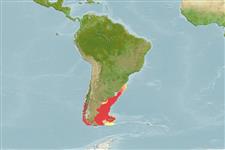Common names from other countries
Environment: milieu / climate zone / depth range / distribution range
Ecologia
; intervalo de profundidade 2 - 250 m (Ref. 87801). Temperate, preferred 12°C (Ref. 107945); 30°S - 55°S, 76°W - 50°W
Southeast Pacific and Southwest Atlantic: from Valparaiso to Magallanes, Rio Grande do Sul, Brazil then south to Falkland Islands.
Length at first maturity / Tamanho / Peso / Idade
Maturity: Lm ? range ? - ? cm Max length : 2.8 cm SHH macho/indeterminado; (Ref. 81902)
Maximum length is based on data from Chile (Ref. 81902). Maximum depth from Ref. 111854. It is an infaunal species found on sandy, muddy, gravel and shell covered substrates at depths of 2 to 80 meters. Gonochoric species with free-living larvae (Ref. 87801). It is found in forests of Macrocystis pyrifera (Ref. 92889).
Life cycle and mating behavior
Maturidade | Reprodução | Desova | Ovos | Fecundidade | Larvas
Members of the class Bivalvia are mostly gonochoric, some are protandric hermaphrodites. Life cycle: Embryos develop into free-swimming trocophore larvae, succeeded by the bivalve veliger, resembling a miniature clam.
SAUP Database. 2006. (Ref. 356)
Status na Lista Vermelha da IUCN (Ref. 130435)
Status no CITES (Ref. 108899)
Not Evaluated
Not Evaluated
Uso pelos humanos
Pescarias: espécies comerciais
FAO - pescarias: landings | FishSource | Sea Around Us
Ferramentas
Fontes da internet
Estimates based on models
Resiliência
Médio, tempo mínimo de duplicação da população 1,4 - 4,4 anos (K=0.29).
